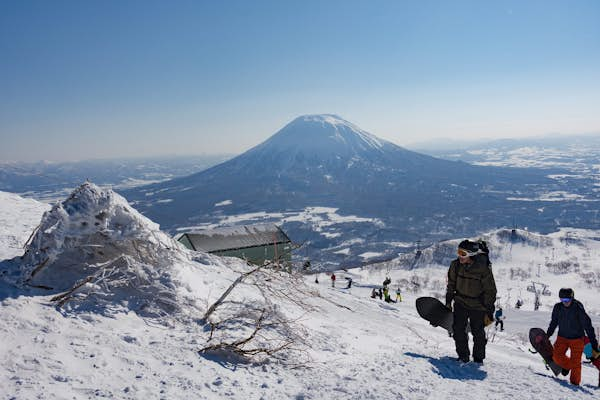Hokkaido is Japan’s northernmost prefecture and much of it is an unspoilt wilderness. Though the island accounts for 20% of the country’s area, it is home to only 5% of its population. In summer, Hokkaido is a land of forests, lakes and meadows, but come winter that landscape is covered in thick powder snow.
The island is transformed into a sullen-skied Narnia where soaring mountain peaks and bare-limbed trees populate an all-consuming carpet of white, surrounded by the icy blue sea.

World-class skiing in Niseko
The number one reason to come to Hokkaido in winter is Niseko, the island’s premier ski resort with what many ski buffs claim is the best snow in the world. There are fresh falls of soft powder snow pretty much every day here, which is great for beginners as the conditions help newbies make big strides with their skiing, while temperatures rarely drop below -5C. The resort also has a long season, running from late November to early May, and is very international, so there are few language barriers to bar visitors’ enjoyment.
Niseko is made up of four interconnected towns and villages clustered around the eastern slopes of Niseko Annupuri mountain. Hirafu has the bulk of the nightlife, while Annupuri, Niseko Village and Hanazono are the sleepier locations. The Green Leaf Niseko Village is one lovely option for accommodations – a particular highlight is its gorgeous onsen (hot spring) set in a natural rock pool surrounded by pine trees. It’s a sublime place to wile away an icy winter night.
Further east, the town of Kutchan has decent restaurants and bars where you can get a true taste of Japanese culture, a quality that distinguishes the Niseko area from Japan’s other ski destinations, which can feel less authentically Japanese.

Snow sculptures in Sapporo
Hokkaido’s biggest city is Sapporo, and it’s worth a visit at any time of year for its top-notch dining, shopping and nightlife. If you’re there in early February, time your visit to coincide with Sapporo Snow Festival, which started in 1950 when local teenagers built six snow statues in Ōdōri-kōen, the city’s main park. Starting from the Sapporo TV Tower, walk through the park, and you’ll pass an artificial ski slope where skiers and snowboarders do their thing, food vendors selling noodles and hot wine, and stages hosting performances from choirs and girl bands. Around 11 February (National Foundation Day, the day that marks the mythical founding of Japan in 660BC), many attendees will be brandishing Japanese flags.
And of course, there are the famous ice and snow sculptures everywhere: they might range from anime characters and Star Wars tributes to giant cups of noodle soup with lids that release steam. One surprising sight at the 2019 festival was a huge ice model of Helsinki Cathedral, marking 100 years of friendship between Finland and Japan.

After an afternoon that might render you as chilly as the sculptures you’ve just witnessed, it’s wonderful to warm up over dinner at Sapporo Biergarten. It’s housed in an evocative old brick factory, and the house speciality is lamb that you cook yourself at the table over a naked flame. You’re allowed as much of the food and namesake beer as you can put away in 100 minutes, so you are likely to leave feeling both full and merry.
While in town, stay at Hotel Monterey Edelhof, a tasteful abode apparently inspired by late 19th-century Vienna.

Otaru’s sake and sushi
It’s worth venturing to the port of Otaru, Hokkaido’s trading centre in the early 20th century. You can still see some of that wealth and power today, as the canal is lined with imposing Western-style buildings of stone and brick.
In February, the town holds a snow festival during which the canal is atmospherically illuminated. While there, join a fun tour of Tanaka Sake Brewery to find out how the ubiquitous Japanese rice wine is made, and enjoy tastings in the shop afterwards; then visit local glassmaker Kitaichi Sangōkan, where you can watch the process and purchase the elegant creations. This close to the coast the seafood is unsurprisingly a winner, so dine at Otaru Canal Restaurant Hikari for huge platters of ocean-fresh sushi and sashimi.

Whisky business in Nikka
Even if you’re not a big whisky drinker, a visit to the Nikka Whisky distillery in Yoichi is fun and fascinating. The factory was founded in 1934 by Masataka Taketsuru, who honed his craft in Scotland (Hokkaido is an ideal location for whisky production, as the air quality is similar to that in Scotland). After a talk on the process, you’re shown round the verdant grounds, which are full of historic buildings and lots of original equipment, including seven huge copper stills in the still house. A particularly poignant section of the site is dedicated to Taketsuru’s Scottish wife Rita, whose life was recently immortalised in a popular Japanese TV drama.
You might also like these
Meet the dog that runs a sweet potato stand in Japan
Eastern Hokkaido: adventures on the edge of Japan
Tokyo in winter: what to see, do and eat
Tom travelled to Hokkaido with support from the Government of Japan. Lonely Planet contributors do not accept freebies in exchange for positive coverage.
